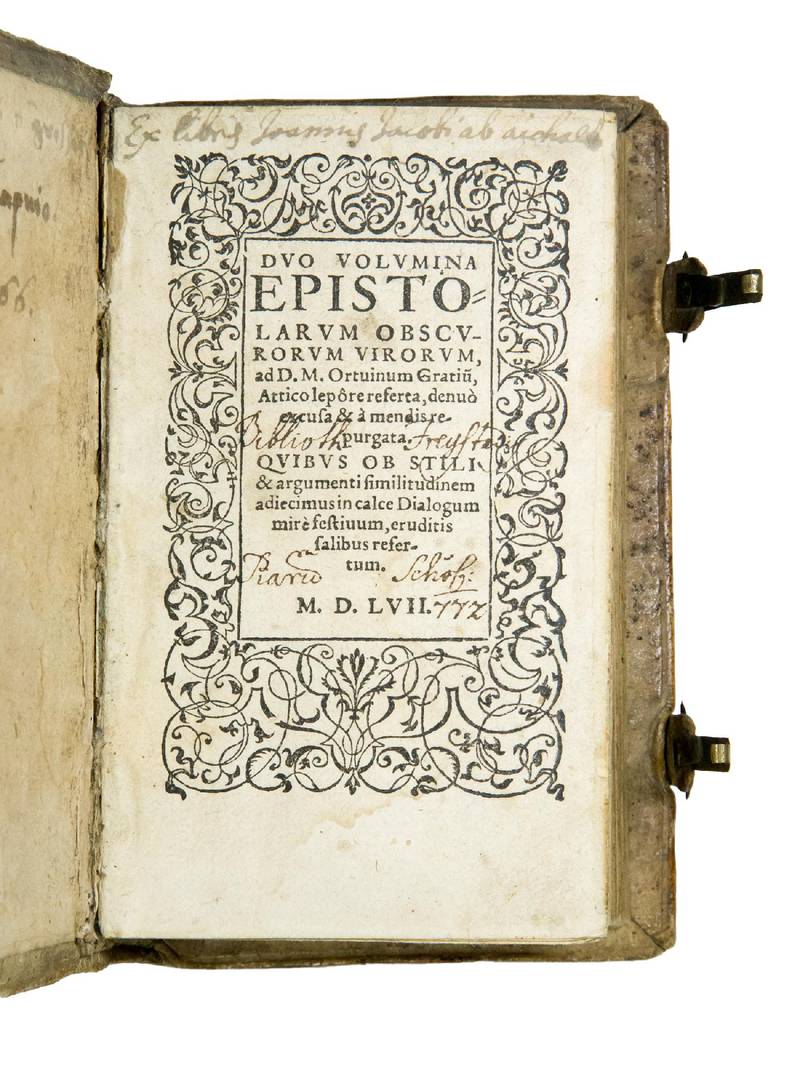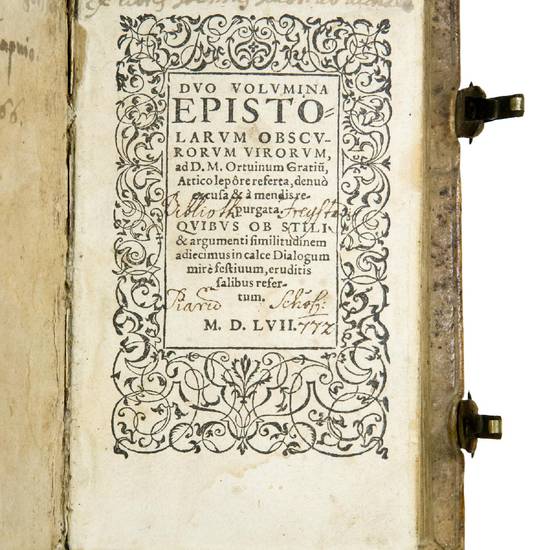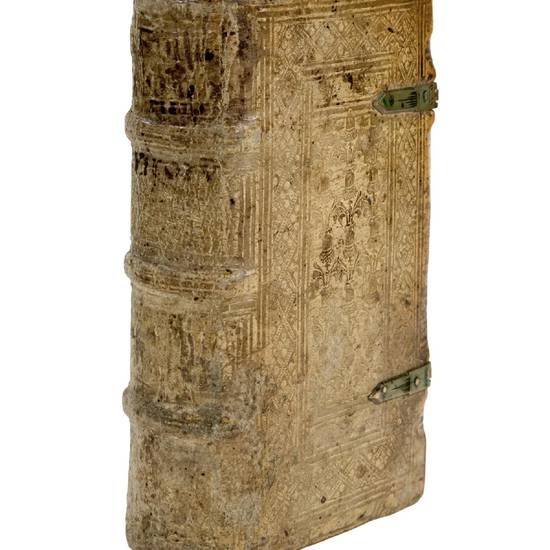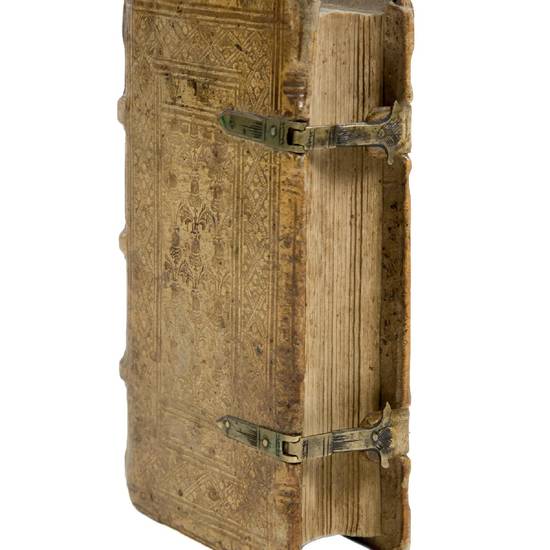Duo volumina epistolarum obscurorum virorum ad D.M. Ortwinum Gratium, Attico lepôre referta, denuò excusa à mendis repurgata. Quibus ob stili & argumenti similitudinem adiecimus in calce Dialogum miré festivum, eruditis salibus refertum. (Romae stampato con privilegio del Papa, & confirmato in lugo qui vulgo dicitur Belvedere)
Autore: CROTUS RUBEANUS, Johannes (1480-1545) & HUTTEN, Ulrich von (1488-1523)
Tipografo: [David Zöpfel]
Dati tipografici: [Frankfurt a.M.], 1557
12mo. (252) leaves. A-X12 (-X12, a blank). Title within an ornamental woodcut border. Contemporary blindstamped pigskin, two clasps, contemporary entry on the inner front panel reading: “Joannis Capnio 1566” (which used to be Reuchlin's Greek name), two old entries of ownership on the title-page.
VD 16, E-1727; J. Benzing, Ulrich von Hutten und seine Drucker, (Wiesbaden, 1953), no. 248; A. Bömer, ed., Epistolae obscurorum virorum, (Heidelberg, 1924), p. 110, no. 10; U. von Hutten, Operum supplementum. Epistolae obscurorum virorum, E. Böcking, ed., (Leipzig, 1869), II/1, p. 14, no. 9.
THIRD EDITION of both parts printed together of a work which is still considered one of the classics of Western literature and the “first modern satire” (B. Könneker, Satire im 16. Jahrhundert. Epoche, Werk, Wirkung, München, 1991, p. 104).
This literary masterpiece originated during the famous controversy in pre-Reformation Germany, the Reuchlin affair. The first part appeared anonymously in Autumn 1515 ‘in impressoria Aldi Manutii', a parodistic allusion to the great Venetian printer, but was really printed by Heinrich Gran at Hagenau. A reprint was produced by Friedrich Peypus in Nuremberg in 1516 and in the Autumn of the same years an augmented edition (seven new letters) was printed by Jakob Schmidt in Speyer (reprinted shortly after in France). In Spring 1517 the second part was published also in Speyer, followed by a reprint in 1518 by Johann Grüninger in Strasbourg. Nearly forty-years elapsed before the two parts were printed together with the false printing place ‘Romae'. This edition was printed at Frankfurt/M. by David Zöpfel in 1556 (with different signatures for the two parts) and again in the same year (with continuous signatures), of which the present edition is a page by page reprint. Zöpfel reprinted it in 1570 and Johann Spies, also in Frankfurt/M. in 1581 and 1599, enriched with some additional material.
The affair began with the efforts of a converted Jew, Johannes Pfefferkorn, to covert his former coreligionists. Backed by the Dominicans at Cologne, he claimed that Jews' religious literature encouraged their resistance. In 1509 Emperor Maximilian I authorized him to examine Jewish books and to destroy any books that impeded conversion. In 1510, however, the archbishop of Mainz, who had friendly relations with the local Jewish community, persuaded the emperor to authorize a study by a group of experts. He sought written opinions from four German theology faculties and three individuals. Johannes Reuchlin (1455-1522), the leading Christian expert on Hebrew, was one of those consulted. All the others endorsed confiscation, but Reuchlin opposed it. Maximilian followed Reuchlin's advice. In the ensuing controversy with the Cologne theologian (especially with the inquisitor Jacob Hoogstraeten) Reuchlin appealed to the papal curia and in 1514 published a collection of letters written by prominent humanists in his defense under the title Epistolae clarorum virorum (‘Letters of Famous Men'). Pope Leo X had no desire to condemn either Reuchlin or the Cologne theologians, and in 1516 issued a mandate imposing silence on both sides. Hoogstraeten, however, continued his attacks and launched a renewed appeal. One small group of humanists countered in Autumn 1515 with a savage satire, Epistolae obscurorum virorum (‘Letters of Obscure Men'). The Epistolae were read by humanists all over Europe, created a favourable milieu for the reception of Luther's doctrines and contributed to the discrediting of scholasticism (cf. H. Holborn, ed., On the Eve of the Reformation: ‘Letters of Obscure Men', New York, 1964, passim; and R.P. Becker, A War of Fools. The Letter of Obscure Men. A Study of the Satire and the Satirized, Bern & New York, 1981, passim).
“Crotus, Hutten, and the other authors of the Epistolae relied primarily in mimic satire to make the opponents of Reuchlin appear ridiculous. Specifically, beginning in 1515 they devised a number of fictitious letters addressed to Ortwin Gratius, the Cologne humanist who had collaborated with the converted Jew Johann Pfefferkorn and powerful theologians at the University of Cologne, including Hochstraten, Arnold von Tongern, and Conrad Köllin, in the prosecution of Reuchlin's case. The letters were supposedly written by former students and friends of the arts professor Gratius. It is now generally agreed that Crotus Rubeanus was the author of most of the forty-one letters in the first series. Hutten had written the very first letter for this first installment, along with seven additional letters which were appended to them in the second edition of 1516. He also was responsible for most of the sixty-two letters published in the next year as a sequel to the first volume. Also contributing to the literary conspiracy were Hermann von dem Busche, who likely promoted Gratius as the butt of the satire, and possibly Jakob Fuchs and other friends of Hutten in Bologna [...] So by constructing letters using everyday Latin spoken in the universities, known as Küchenlatein (kitchen Latin), as well as by adding Latin endings to the vernacular (macaronic Latin) and by following German word order in sentence construction (Barbarolexis), the authors created a mock or mimic style in their satire” (J.V. Mehl, Language, Class, and Mimic Satire in the Characterisation of Correspondents in the ‘Epistolae obscurorum virorum', in: “The Sixteenth Century Journal”, 25/2, 1994, pp. 291-293; see also W. Brecht, Die Verfasser der ‘Epistolae obscurorum virorum', Strassburg, 1904, passim; and R. Hahn, Huttens Anteil an den ‘Epistolae obscurorum virorum', in: “Pirckheimer-Jahrbuch”, 1988, pp. 79-111).
The Epistolae were banned by a bull issued by pope Leo X on March 15, 1517 and the authors, disseminators and readers excommunicated.
Johannes Crotus Rubeanus was born in Dornheim in Thuringia and entered the University of Erfurt in 1498. He became a leader of the young Erfurt poets and a friend of Conrad Mutianus Rufus and Ulrich von Hutten. After working as a tutor, he became director of the abbey school of Fulda (1510-1516). In 1517 he travelled to Italy and took a doctorate in theology at Bologna. On his return to Germany he was appointed rector of the University of Erfurt. When Luther passed through that city en route to the Diet of Worms (April, 1521), Crotus welcomed him to the university. In 1524 he became chancellor to Albert of Brandenburg and was instrumental in transforming Prussia into a secular Protestant duchy. In 1530 he reverted to Catholicism and entered the services of the archbishop of Mainz, and became a cathedral canon at Halle and Halberstadt. He defended his repudiation of the Reformation in an Apologia (1531) that prompted several Protestant responses, but he refused either to respond to attacks or to write any more books (cf. W. Stammler, ed., Deutscher Humanismus, 1480-1520, Verfasserlexikon, Berlin & New York, 1977, I, cols. 505-508).
Ulrich von Hutten was born into a family of imperial knights in the castle of Steckelberg (near Fulda in Hesse). He entered the school of the Benedictine abbey in Fulda in 1499, but left the school against the will of his parents in 1505, spending the next six years as a wandering student in several German universities. On his way to Italy (1511) to study law he visited Joachim Vadian in Vienna and other humanists in the circle of Emperor Maximilian. After studying at the universities of Pavia and Bologna and serving briefly in the army of Maximilian, Hutten returned to Germany in 1514, securing for himself the patronage of Archbishop Albrecht of Mainz and devoting himself to scholarship and poetry. The following year his life was permanently changed by the murder of his kinsman Hans von Hutten by Ulrich, Duke of Württemberg, which prompted the Hutten family to embark on a long feud with that powerful prince. During a second stay in Italy (1515-1517) he wrote a series of epigrams denouncing not only the enemies of Emperor Maximilian, but also Pope Julius II. When he returned to Germany he was crowned poet laureate by the emperor and entered the service of the archbishop of Mainz. In 1519 he collected his attacks on Duke Ulrich in a single volume. When Archbishop Albert denounced Hutten at Rome, he became a supporter of Luther and his calls for religious reform. Unlike Luther, Hutten tried to enforce reformation by military means when he, along with Franz von Sickingen, attempted to begin popular crusade within the Holy Roman Empire against the power of the Roman Catholic Church in favour of Luther's reformed religion. In what is known as the Knight's Revolt, they attacked the lands of the Archbishop in 1522. The archbishop held out, however, and the knights were eventually defeated in 1523, destroying them as a significant political force within the empire. Following his defeat, Hutten tried to convince Erasmus of Rotterdam to side with the Reformation. Erasmus refused to take sides, and he also refused to see Hutten when the latter came to Basel in 1523, ill and impoverished, to see him. Their estrangement culminated in a literary quarrel. Hutten then travelled to Zürich, where he was welcomed by Zwingli, who arranged for him to live with the pastor of Ufenau, a small island on Lake Zürich. There he died at the end of the Summer, aged thirty-five, of the syphilis that he had contracted several years earlier and on which he had written a treatise De morbo gallico (1519). Hutten's life may have been reckless and ill managed, but his prodigious talent made him Germany's greatest neo-Latin writer and, when he translated his Lucianic dialogues into vigorous German (Gespächsbüchlein, 1521), he set a standard for German satire that has seldom be matched. In both languages he was a central figure in the development of the Renaissance dialogue (cf. S. Wheelis, Ulrich von Hutten: Representative of Patriotic Humanism, in: “The Renaissance and Reformation in German”, H. Hoffmeister, ed., New York, 1977, pp. 111-127).
At the end of the first part is printed the Dialogus novus et mire festivus, ex quorundam virorum salibus cribratus, a satirical dialogue variously attributed to Ulrich von Hutten, which appeared for the first time in 1519. In it three Cologne theologians (Ortwin Gratius, Gingolphus, and Leopoldus) are opposed to three major humanists of the time (Reuchlin, Erasmus, and Lefèvre d'Etaples) (cf. N. Istasse, Le ‘Gingolphe' de J. Ravisius Textor et la pseudohutténienne ‘Conférence macaronique', in: “Humanistica Lovaniensia”, LX, 2011, pp. 85-98).
[9142]






